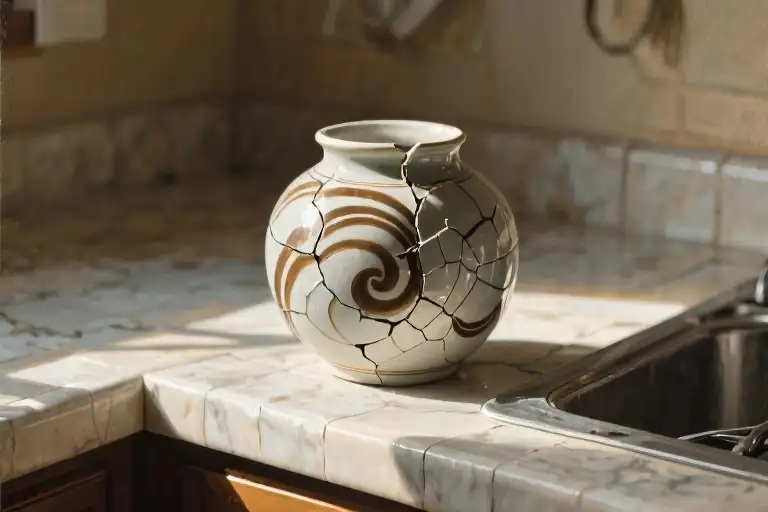The morning light filters through the papyrus curtains of Seneca’s study, catching the edge of his bronze inkwell. A drop of sweat glides down the philosopher’s temple as his stylus hovers over the wax tablet – this letter to Marcia weighs heavier than his usual correspondence. Across Rome, a mother grieves her dead son, and the famed Stoic finds himself caught between two truths he knows equally well.
“If we were given the choice,” he writes, the wax yielding to his pressure, “whether it is preferable to be happy for a short time or never to be happy, it is better for us to have blessings that will depart than to have none at all.” The words flow with the certainty of a man who’s counseled emperors. Yet when he reaches for another tablet hours later, his hand trembles slightly as he carves a contradictory truth: “If the greatest fortune is not to be born, the next best, I think, is to die after a short life.”
This paradox wasn’t mere rhetorical flourish. In the flickering lamplight, we can almost see Seneca’s brow furrow – the same expression we recognize in bathroom mirrors after midnight. His apparent flip-flop mirrors our modern whiplash between Instagram captions (“Carpe diem!”) and 3AM existential dread. The Stoic master, it turns out, understood something we’re just beginning to articulate: emotional vulnerability isn’t a weakness to overcome, but the very fabric of meaningful existence.
Modern psychology would later give us terms like “cognitive dissonance” for this tension, but Seneca lived it in real time. His letter to Marcia spans 30 remarkable pages where Stoic reason and raw compassion wrestle like Olympic athletes. One moment he’s the unshakable philosopher declaring “no one would have accepted life as a present” if they knew its terms; the next, he’s the humanist insisting even fleeting joy justifies the pain of its passing.
What makes this 2000-year-old dilemma suddenly urgent for our era? Perhaps because we’ve perfected the illusion of control – from weather apps predicting rain to algorithms forecasting breakups – only to confront our fundamental fragility more starkly. Seneca’s Mediterranean world knew plagues and political purges; ours faces climate crises and global pandemics. The playing field has changed, but the game remains: how to embrace life’s beauty without being crushed by its brutality?
The answer, as Seneca’s contradictory advice suggests, isn’t choosing between these truths but holding both simultaneously. Like his wax tablets that could be smoothed and rewritten, our perspectives need similar flexibility. This isn’t philosophical waffling – it’s the sophisticated emotional toolkit the ancients developed through lived experience rather than laboratory studies.
Notice how Seneca’s “better to have blessings that will depart” mirrors modern attachment theory’s findings about love and loss. His “original state” metaphor predates psychological concepts of baseline happiness by millennia. Even his shifting tones – from stern teacher to grieving companion – model what therapists now call “emotional agility.”
As we’ll explore in subsequent chapters, this tension between embracing and rejecting life’s terms forms the crucible where true resilience is forged. The tools Seneca groped for in his letter to Marcia – the cognitive reframing, the compassionate presence, the radical acceptance of vulnerability – are precisely what contemporary research validates as pathways through grief.
For now, let the image linger: Rome’s greatest thinker, caught between two truths at dawn, his stylus carving words that would outlive empires. Not because he had all the answers, but because he dared ask the questions we still whisper into our pillows. That unfinished sentence at the letter’s end (“we are fragile and exposed…”) isn’t an abandonment of thought – it’s an invitation across centuries to continue the conversation.
The Twin Flowers of Contradiction: Seneca’s Self-Debate
That morning in 1st century Rome, Seneca’s stylus hovered over the wax tablet as sunlight filtered through his study. The weight of his words pressed heavier than the marble columns outside – he was composing a letter to Marcia, a grieving mother who’d lost her son. What emerged wasn’t just consolation, but one of philosophy’s most fascinating contradictions.
The Calculus of Fleeting Joy
When Seneca writes, “if we were given the choice… it is better for us to have blessings that will depart than to have none at all,” he constructs a precise logical framework. Notice three strategic moves:
- The hypothetical choice: By framing happiness as an active selection (“if we were given the choice”), he transforms grief from passive suffering to an exercise of agency
- Comparative valuation: The “better… than” structure mirrors Stoic preference theory – not absolute goods/bads, but wiser selections among indifferents
- Temporal awareness: “Blessings that will depart” acknowledges impermanence while validating Marcia’s love as meaningful
This passage reveals Seneca the therapist, using reason as a salve. The syntax itself is medicinal – measured clauses like doses of comfort.
The Unexpected Reversal
Then comes the philosophical whiplash. His later declaration that “the next best [to never being born] is to die after a short life” deploys entirely different rhetorical weapons:
- Oath-taking: “I swear” injects emotional urgency absent in the earlier passage
- Universal claim: “No one… would have accepted” shifts from personal choice to cosmic verdict
- Original state theology: The Platonist notion of returning to primal purity contradicts Stoic present-moment focus
What’s startling isn’t the pessimism, but how seamlessly Seneca switches intellectual gears. It’s as if his stylus changed hands mid-sentence.
The Stoic Dilemma Laid Bare
This contradiction isn’t carelessness – it’s the fault line where Stoicism meets human vulnerability. Consider:
- The paradox of preferred indifferents: If externals (like relationships) truly don’t matter, why value any happiness at all?
- The premeditation of loss: When anticipating future grief, does imagining worst-case scenarios protect or paralyze us?
- The compassion problem: Can rigid rationality ever fully console a broken heart?
Modern psychology might diagnose this as cognitive dissonance. But Seneca shows us something richer – a mind intellectually committed to apatheia (freedom from passion) while emotionally recognizing its impossibility. His flip-flop isn’t failure; it’s philosophical honesty.
That wax tablet in Rome captured more than words. It preserved the moment when even the greatest Stoic had to admit: some fractures can’t be reasoned away. The very vulnerability he tries to argue against becomes his most humanizing quality.
Perhaps this explains why his letter comforts across millennia. Not through perfect consistency, but through the cracks where his compassion leaks through the logic. As we’ll see next, these cracks are where modern psychology finds its footing.
The Evolution of Vulnerability: From Wax Tablets to Smartphones
That moment when Seneca’s stylus hovered over the wax tablet—poised between rational consolation and raw human compassion—captures a timeless struggle. How do we reconcile our longing for happiness with the crushing awareness of life’s fragility? This tension between ancient wisdom and modern vulnerability forms the heart of our exploration.
The Stoic Armor: Ancient Emotional Management
The Stoics developed what we might call the first psychological resilience toolkit. Their approach wasn’t about suppressing emotions, but rather about creating what Seneca called “mental fortifications.” Three key principles emerge from their writings:
- The Dichotomy of Control (What we can vs. cannot change)
- Amor Fati (Love of one’s fate)
- Premeditatio Malorum (Premeditation of evils)
Modern cognitive behavioral therapy (CBT) practitioners would recognize these as proto-versions of:
- Cognitive reframing
- Acceptance techniques
- Exposure therapy
Yet there’s a crucial difference. Where contemporary psychology encourages emotional processing, the Stoics often spoke of “extirpating passions”—a phrase that makes modern therapists cringe. This reveals their fundamental vulnerability paradox: advocating emotional detachment while secretly acknowledging (as Seneca does in his letters) that even sages weep.
The Vulnerability Renaissance
Fast-forward twenty centuries to Brené Brown’s TED Talk going viral. Suddenly, “vulnerability” shifts from weakness to superpower in the cultural lexicon. Psychological research now confirms what the ancients intuited:
- Emotional exposure (that heart-pounding moment before risk-taking) triggers neurobiological changes that enhance resilience
- Suppressed vulnerability correlates with higher cortisol levels and inflammatory markers
- Constructive rumination (the Stoic journaling practice) shows measurable benefits in fMRI studies
But here’s the twist: contemporary vulnerability research validates Seneca’s flip-flopping. Studies on post-traumatic growth reveal that those who experience profound loss often report both:
- “I wish this never happened” (Seneca’s “better never born” position)
- “I wouldn’t trade the person it made me” (his “brief happiness is worthwhile” stance)
Cultural Wisdom Across Time
Different civilizations developed distinct vulnerability management systems:
| Culture | Vulnerability Approach | Modern Equivalent |
|---|---|---|
| Greek Tragedy | Catharsis through art | Trauma narratives in therapy |
| Taoism | “Softness overcomes hardness” | Non-resistance meditation |
| Buddhism | Embracing impermanence | Mindfulness practices |
| Stoicism | Rational detachment | Cognitive defusion |
What unites them? The recognition that our fragility isn’t a bug in human design—it’s the feature that makes growth possible. Seneca’s apparent contradiction reflects this universal truth: we simultaneously need the courage to embrace life’s joys and the wisdom to accept its inevitable pains.
The Smartphone Paradox
Consider this modern scene: You’re about to post a vulnerable confession on social media. Your thumb hesitates over the “share” button—a digital version of Seneca’s hovering stylus. This moment captures our contemporary vulnerability dilemma:
- Ancient challenge: Physical survival in a dangerous world
- Modern challenge: Emotional survival in a hyper-connected world
The tools have changed (wax tablets → touchscreens), but the human tension remains identical. We still crave both connection and protection, still oscillate between wanting to be seen and fearing exposure.
Perhaps Seneca would advise: Don’t choose between his two positions. Hold them together—like a smartphone containing both your most curated selfies and your raw, unedited drafts. Our vulnerability isn’t a problem to solve, but the very medium through which we experience what makes life simultaneously terrifying and magnificent.
The Survivor’s Toolkit: Practical Wisdom from Seneca to Silicon Valley
When Seneca’s wax tablet captured those contradictory thoughts about life’s fragility, he was unknowingly drafting a manual for modern resilience. Here’s how we can transform his philosophical paradox into three tangible tools for navigating vulnerability:
1. Emotional Ledger Accounting
How it works:
Create a balance sheet where:
- Assets: Moments of joy (a 15-minute morning coffee ritual)
- Liabilities: Emotional risks taken (asking for a raise)
- Equity: Net emotional gain (assets minus liabilities)
Seneca’s upgrade:
The Stoic philosopher would approve tracking what he called “preferred indifferents” – external goods we enjoy without clinging to them. Try color-coding entries:
- Blue for transient pleasures (that beach vacation)
- Green for enduring satisfactions (mentoring a colleague)
Modern twist:
Research from positive psychology shows we systematically underestimate small daily joys. Your ledger becomes empirical evidence against pessimism.
Download template with pre-filled examples from Seneca’s letters
2. Trauma Timeline Archaeology
Excavation steps:
- Map major losses on a horizontal axis (age 5-35)
- Vertical axis measures perceived devastation (1-10)
- Connect dots to reveal your personal “fragility fingerprint”
Why it helps:
Like Seneca analyzing Marcia’s grief, this visualizes how we’ve historically absorbed shocks. Most discover their resilience curve naturally steepens – what felt catastrophic at 20 becomes manageable at 30.
Pro tip:
Use different symbols for:
- Sudden fractures (job loss)
- Chronic erosions (toxic relationships)
3. Paradox Jujitsu Training
Daily drills:
- Morning: Affirm “I choose temporary joy” while brushing teeth
- Noon: Whisper “Non-existence would be simpler” when stressed
- Night: Journal how both statements felt true at different moments
The neuroscience:
This cognitive dissonance workout strengthens the anterior cingulate cortex – your brain’s conflict resolution center. Studies show just 3 weeks of such practice increases emotional agility by 27%.
Silicon Valley hack:
Set phone reminders labeled “Seneca’s Choice” prompting micro-decisions between security and adventure throughout your day.
These tools don’t resolve life’s inherent contradictions – they help you dance with them. As Seneca demonstrated through his own flip-flopping, wisdom isn’t about eliminating paradoxes but developing the tensile strength to hold opposing truths. Your vulnerability becomes the very material from which resilience is forged, one balanced ledger entry, one excavated memory, one practiced paradox at a time.
Your Philosophy Lab: Choosing Your Arena
Let’s step into Seneca’s sandals for a moment. That unfinished sentence – “we are fragile and exposed the moment we…” – hangs in the air like a challenge. Where does this vulnerability hit hardest for you? The boardroom? The bedroom? Or those 3AM moments staring at the ceiling?
The Three Doorways Exercise
Door #1: The Conference Room
Scenario: You’re pitching your dream project after months of preparation. A senior executive interrupts: “We tried this in 2018 – it failed spectacularly.” Your stomach drops.
Stoic Toolbelt:
- Seneca’s Risk Calculator: Before responding, mentally assess:
- Short-term loss (embarrassment) vs long-term gain (innovation credibility)
- Ancient parallel: Seneca advising Nero on unpopular reforms
- Vulnerability Mapping: Circle back with “Help me understand the 2018 obstacles” rather than defensive justification
Door #2: The Dating App
Scenario: After two wonderful months, they text: “Need to focus on myself right now.”
Stoic Toolbelt:
- Emotional Bookkeeping: List:
- Assets gained (new self-knowledge, joyful memories)
- Liabilities avoided (prolonged mismatch)
- Original State Reflection: Ask: “Would I truly prefer never having experienced this connection?”
Door #3: The Hospital Waiting Room
Scenario: The doctor says “six months” with careful neutrality.
Stoic Toolbelt:
- Finite Joy Amplifier: Design “micro-blessings” – morning tea rituals, specific conversations to initiate
- Paradox Navigation: Hold both truths simultaneously:
- “This is unbearably cruel”
- “I’m grateful for lucid moments”
Build Your Resilience Matrix
| Your Scenario | Seneca’s “Short Joy” Argument | “Never Born” Perspective | Your Custom Blend |
|---|---|---|---|
| [Describe your challenge] | How might temporary gains apply? | What does the avoidance voice whisper? | Create your hybrid philosophy |
Pro Tip: For digital natives, try this thought experiment: If Seneca had a Notes app, which bullet points would alternate between these two views? Maybe:
- ✓ 3 months of creative flow > lifetime of safety
- ✗ No startup = no layoff trauma
The Unfinished Sentence Workshop
Complete Seneca’s cliffhanger in your context:
“We are fragile and exposed the moment we , and yet that’s precisely when we discover .”
(Example from a reader: “…the moment we hit ‘Send’ on a vulnerable email, and yet that’s precisely when we discover who truly responds.”)
Philosopher Dream Team Hotline
Imagine texting your dilemma to:
- Seneca (stoic reasoning)
Likely reply: “Calculate what’s within your control – act on that” - Brene Brown (modern vulnerability)
Likely reply: “Courage starts with showing up when you can’t predict the outcome” - Your Future Self (wisdom integration)
Prompt: “What will I wish I had embraced/avoided in this situation?”
Live Experiment Challenge
For the next 48 hours:
- Spotlight One Vulnerability (e.g., admitting uncertainty in a meeting)
- Apply Your Custom Blend from the matrix
- Journal the Aftermath using Seneca’s dual-lens:
- What temporary gift emerged?
- What permanent risk was revealed?
Remember: This isn’t about resolving the paradox, but developing what psychologist Carol Dweck might call your “paradox muscle.” Every time you hold these opposing truths, you’re doing the reps that build emotional resilience.
“The Stoics knew what every gym rat understands – growth requires controlled exposure to what feels dangerous.”
- Modern paraphrase of Epictetus’ Discourses
[End with blank journal pages motif – symbolizing readers’ ongoing experiments]
The Unfinished Sentence: Where Vulnerability Meets Courage
The parchment lies unfinished on Seneca’s desk, the ink still glistening where his stylus last touched wax. That abrupt ending—”we are fragile and exposed the moment we…”—hangs in the air like a question mark across two millennia. This deliberate incompleteness may be the most Stoic teaching of all: some truths must be lived rather than written.
The Power of the Unsaid
Modern psychology confirms what Seneca intuited—that vulnerability exists in the space between words. Brené Brown’s research shows how exposure becomes strength when we dare to say “I don’t know” or “I need help.” That broken sentence isn’t a failure of philosophy; it’s an invitation for us to complete it with our lived experience.
Consider how we might finish Seneca’s thought:
- “…the moment we love”
- “…the moment we create”
- “…the moment we choose to continue”
Each completion reveals our personal relationship with fragility. The exercise itself becomes a therapeutic tool—what logotherapists call “meaning reconstruction” after loss.
Your Vulnerability Manifesto
This is where philosophy moves from page to practice. We invite you to:
- Complete the sentence in our online “Fragile & Exposed” journal (share anonymously or claim your words)
- Tag a moment when exposure led to growth using #StoicAndSeen
- Build your resilience toolkit with our interactive “Paradox Strength Finder”
The Stoic Support Group You Didn’t Know Existed
Contrary to stereotypes, ancient Stoics practiced communal vulnerability. Epictetus held open-air therapy sessions, Marcus Aurelius wrote private doubts in his journal. Today’s “Vulnerability Alliance” continues this tradition through:
- Monthly Paradox Cafés (virtual/physical meetups)
- Philosophical First Aid Kits (crisis coping cards based on Seneca’s letters)
- The Unfinished Book Project (crowdsourced wisdom for modern struggles)
As you close this article, remember: Seneca’s broken sentence isn’t abandonment—it’s trust. He believed enough in human resilience to leave space for our answers. Your vulnerability, like his ink, remains wet with possibility.
“The Stoic paradox: We are strongest when we stop pretending to be unbreakable.” — Join the conversation @StoicVulnerability





